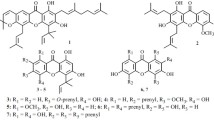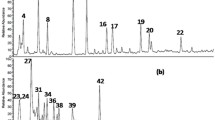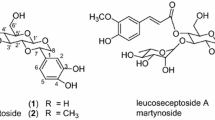Abstract
A CHCl3: MeOH extract of the fruit ofLycium chinense Mill. (Solanaceae) was found to afford significant protection against carbon tetrachloride-induced toxicity in primary cultures of rat hepatocytes. Subsequent activity-guided fractionation resulted in the isolation of zeaxanthin and zeaxanthin dipalmitate as antihepatotoxic components. Incubation of injured hepatocytes with zeaxanthin dipalmitate reduced the levels of glutamic pyruvic transaminase (GPT) and sorbitol dehydrogenase (SDH) released from damaged cells to 60.5% and 76.3% of those released from untreated controls, respectively. Zeaxanthin also reduced the levels of GPT and SDH to 68.5% and 61.3% of the levels of those released from the untreated control. The results confirm the hepatoprotective activities of zeaxanthins. Antihepatotoxic activities of zeaxanthins are comparable to that of silybin.
Similar content being viewed by others
References Cited
Bartlett, L., Klyne, W., Mose, W. P., Scopes, P. M., Galasco, G., Mallams, A. K., Weedon, B. C. L., Szabolcs, J. and Toth, G., Optical rotatory dispersion of carotenoids.J. Chem. Soc. C., 2527–2544 (1969).
Berry, M. N. and Friend, D. S., High yield preparation of isolated rat liver parenchymal cells.J. Cell. Biol., 43, 506–520 (1984).
Berry, M. N., Edward, A. M. and Barritt, G. J., High-yield preparation of isolated hepatocytes from rat liver. In Burdon, R. H. and Knippenberg, P. H. (Eds.).Laboratory Techniques in Biochemistry and Molecular Biology. Elsevier, New York, vol. 21, pp. 15–58, 1991.
Bonnett, R., Mallams, A. K., Spark, A. A., Tee, J. L., Weedon, B. C. L. and McCormick, A., Carotenoids and related compounds, Part XX, Structure and reactions of fucoxanthin.J. Chem. Soc. C., 429–454 (1969).
Clccio, J. F. and Castro, V. H., Fisalieno, colorante de los frutus maduros de plants.Rev. Latinoam. Quim., 15, 24–25 (1984).
Gerlach, U., Sorbitol dehydrogenase, In Bergmeyer, H. U. (Ed.).Methods of Enzymatic Analysis. pp. 761–765, 1965.
Goowin, T. W. and Britton, G., Distribution and Analysis of Carotenoids: In Goowin, T. W. (Ed.).Plant Pigments. Academic Press, London, UK, pp. 61–132, 1988.
Itoh, T., Tamura, T. and Matsumoto, T., Four new and other 4-methylsterols in the seeds of Solanaceae.Phytochem., 17, 971–977 (1978).
Kim, S. Y., Choi, Y., Huh, H., Kim, J., Kim, Y. C. and Lee, H. S., New antihepatotoxic cerebroside fromLycium chinense fruits.J. Nat. Prod., 60, 274–276 (1997).
Kiso, Y., Tohkin, M. and Hikino, H., Assay method for antihepatotoxic activity using carbon tetrachloride induced cytotoxicity in primary cultured hepatocytes.Planta Med., 49, 222–225 (1983).
Kukokawa, S., General pharmacological studies of the water and various organic solvent soluble components derived fromLycium chinense.Shikoku Igaku Zasshi, 18, 127–136 (1962).
Lee, M. K., Choi, Y. J., Sung, S. H., Shin, D. I., Kim, J. and Kim, Y. C., Antihepatotoxic activity of icariin, a major constituent ofEpimedium koreanum.Planta Medica, 61, 523–526 (1995).
Maldoni, B. E., Alcaloides en dos especifs de Lycium.Rev. Latinoam. Quim., 15, 83 (1984).
Moss, G. P., Carbon-13NMR spectra of carotenoids.Pure & Appl. Chem., 47, 97–102 (1976).
Nishiyama, R., Betaine ofLycium chinense.Nippon Shokuhin Kogyo Gakkaishi, 10, 517–519 (1963).
Reitman, S. and Frankel, S., A colorimetric method for the determination of glutamic oxaloacetic and glutamic pyruvic transaminase.Am. J. Clin. Pathol., 28, 56–63 (1957).
Sannai, A., Fujimori, T. and Kato, K., Neutral volatile components of “Kukoshi” (Lycium chinense M.).Agric. Biol. Chem., 47, 2397–2399 (1983).
Author information
Authors and Affiliations
Rights and permissions
About this article
Cite this article
Kim, S.Y., Kim, H.P., Huh, H. et al. Antihepatotoxic zeaxanthins from the fruits ofLycium chinense . Arch. Pharm. Res. 20, 529–532 (1997). https://doi.org/10.1007/BF02975206
Received:
Issue Date:
DOI: https://doi.org/10.1007/BF02975206




